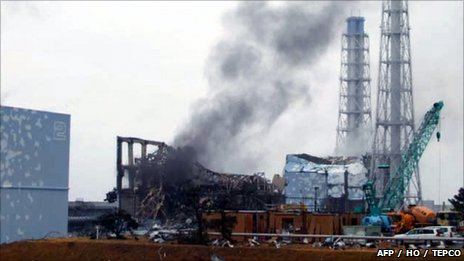

The contamination of the Pacific Ocean with more than 9 Peta-Becquerel of cesium-137 (1 PBq = 1 quadrillion Becquerel) and more than 68 PBq of iodine-131 constitutes the largest radioactive discharge into the world’s oceans ever recorded. In addition, strontium-90, xenon-133, plutonium-239 and more than two dozen other radioactive substances were emitted. Total atmospheric emission in the first four days of the Fukushima nuclear disaster most likely amounted to about 20 % of the total iodine-131 emissions and 40–60 % of the total cesium-137 emissions of the Chernobyl catastrophe. On April 12, the Fukushima nuclear meltdowns were categorized as a level 7 nuclear accident – the highest level on the International Nuclear Event Scale (INES), previously reached only by the Chernobyl disaster.

Despite better knowledge, the government failed to order the distribution of stable iodine to the general population – most likely to prevent mass panic. Highly contaminated places outside this zone, such as Iitate or Namie, were only evacuated weeks later and in the initial chaos some people were even sent to places of higher contamination. The most severe contamination occurred on March 15, when radioactive particles were blown northwest towards the villages of Iitate and Namie, which are among the most heavily contaminated municipalities today.Ī total of 200,000 people were forced to leave their homes in a 20 km zone around the power plant. About 79 % of fallout occurred over the Pacific Ocean, the rest spread over mainland Japan, including metropolitan Tokyo. Also, emissions from fires, explosions, evaporation and deliberate venting caused several radioactive clouds, which spread nuclear fallout in all directions. These desperate measures were able to prevent larger explosions such as in Chernobyl, but at the same time led to a massive radioactive contamination of groundwater reservoirs and the ocean. TEPCO, the company responsible for the plant, began to vent radioactive steam and pumped seawater into the reactors for cooling. The heat and pressure from the melting fuel rods caused multiple explosions and a fire in the spent fuel pond of reactor 4. According to TEPCO, all fuel rods in reactor 1 melted, as did 57 % of the fuel rods in reactor 2 and 63 % of those in reactor 3. With no electricity to power the cooling systems, water inside the reactors began to boil off, causing meltdowns of the fuel rods. The tsunami that followed wreaked further havoc on the region and complicated the situation. On March 11, 2011, a magnitude 9.0 earthquake hit Northeastern Japan, severely damaging the Fukushima Dai-ichi nuclear power plant. Every single case of cancer is one too many.
#Fukushima 3rd reactor meltdown full#
It is still too early to predict the full extent of health effects of the disaster, but due to the high amount of radioactivity released, it must be assumed that several tens of thousands of excess cancer cases will occur in the coming decades. In addition, it contaminated soil, air, food and drink and exposed the public to dangerous levels of radiation. The three reactor meltdowns at the Fukushima Dai-ichi nuclear power plant in March 2011 caused the greatest radioactive contamination of the world’s oceans ever recorded.


 0 kommentar(er)
0 kommentar(er)
